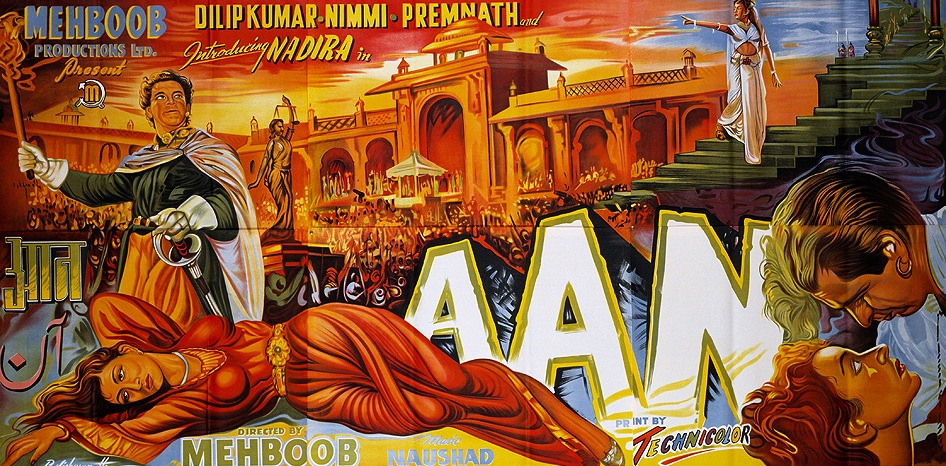Jai Tilak (Dilip Kumar) belongs to a Rajput clan loyal to the kind and just king (Murad). However, the Maharaja’s wicked son, Shamsher Singh (Premnath), usurps the throne by killing his father. Jai meanwhile clashes with the haughty princess Rajshree (Nadira), sister of Shamsher Singh as he tames her wild stallion. Falling in love with her, he resolves to tame her as well and make reciprocate. Mangala (Nimmi), a fellow clanswoman, too loves Jai. She catches Shamsher’s eye and he kidnaps her and tries to rape her causing her to fall to her death. In retaliation, Jai kidnaps Rajshree. Eventually Rajshree does fall in love with Jai. It also turns out that the king is alive after all and Jai, a now reformed Rajshree and the loyal clansmen help defeat Shamsher and restore the king to the throne.
Aan remains one of the best swashbuckling films in Indian Cinema having an epic feel reminiscent of Hollywood films like Quo Vadis and Duel in the Sun. The film was Mehboob Khan’s first film in color and even had a release in UK and the USA, titled as Savage Princess, and while it was much appreciated, a critic in London had quipped, “Aan goes aan and aan and aan!”
With colour at his disposal, Mehboob follows a sweeping narrative style for this retelling of the otherwise standard The Taming of the Shrew story, be it the stylized acting or the vast countryside with swashbuckling horsemen thundering under fiery golden skies, peasant folk in their bullock carts and the like, thereby announcing his Mother India (1957) style of socialist realism. The film is shot handsomely by Faredoon A Irani and is one of India’s first successful experiments with colour cinematography as the film was shot in 16mm Gevacolour and was blown up in Technicolor. Highlights include the lavish sets, the horse chases, breathtaking battle scenes and the spectacular finale with the sword fight between Dilip Kumar and Premnath in front of a pyre with Nadira bound to the stake. It is said that during the shooting of this sequence, Nadira actually was singed by the flames but carried on with the scene gamely.
The film is also aided greatly by Dilip Kumar’s swashbuckling and greatly entertaining performance as Jai. Regarded as perhaps India’s greatest actor ever and though known more for his intense, tragic roles, he proves here that he could be equally adept while swinging on chandeliers, taming the haughty heroine and indulging in flashy swordplay. It is clear he is enjoying himself immensely. In Aan, Mehboob introduces Jewish-born Nadira to Indian audiences and and while her perennially arched eyebrow helped in bringing out her haughtiness all the better, her performance is eye-popping to say the least. Still, Aan made Nadira into a star and along with her vampish turn as Maya in Shree 420 (1955), the role of the arrogant princess, Rajshree, remains her most famous role. Premnath shines as the rogue prince but unfortunately Nimmi’s eyeballing antics and exaggerated pout have not aged well at all with time. Incidentally, Aan was initially announced with Dilip Kumar and three heroines – Nargis, Nadira and Nimmi. But Nargis backed out of the film. It is not clear what role she was to play as the way the film plays out in its current avatar, there is no role for a third leading lady.
A major highlight of the film is Naushad’s music. In keeping with the extravagant nature of the film, Naushad used a 100-piece orchestra while recording the music of the film, something unheard of in those days. He also had special rugs put on the walls of the sound studio so that the sound had better bass. The songs were finally mixed in London. The chart busters composed for the film and rendered perfectly by Mohammed Rafi, Lata Mangeshkar and Shamshad Begum include Maan Mera Ehsan, Aag Lagi Tanman Mein, Tujhe Kho Diya Humne Pa Leneke Baad, Mohabbat Choome Jinke Haath, Dil Mein Chhupake, Aaj Mere Man Mein Sakhi and Main Rani Hoon Raja ki among others. Naushad was also among those Music Directors who took equal care for the background score of the film as he did for its songs. The Background score enhances in creating the sweeping, grandeur feel of the story. Overall, Naushad worked day in and day out for three whole months for the film’s music. The symphony with the 100 musicians was much appreciated and even played on the BBC!
Aan was also released in a shortened dubbed version in French as Mangalla Fille des Indes in 1954 and was the first Hindi Film to be dubbed in Tamil. But the biggest compliment for the film came to Mehboob, regarded as India’s Cecille B DeMille, from DeMille himself. In a letter to Mehboob after seeing the film he wrote, “I believe it is quite possible to make pictures in your great country which will be understood and enjoyed by all nations without sacrificing the culture and customs of India. We look forward to the day when you will be regular contributors to our screen fare with many fine stories bringing the romance and magic of India.”
Hindi, Action, Drama, Color



AAn was shot on EKTACHROME (Kodak co’s stock). GevaColor import and processing was started by FilmCentre (aka: Film Center) few years later (I noted this info. many years ago from a color films history site ) /// SUDHIR July 1 2023